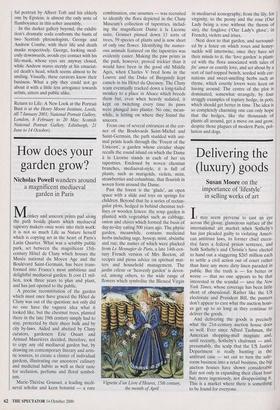How does your garden grow?
Nicholas Powell wanders around a magnificent mediaeval garden in Paris Monkey and unicorn prints pad along the path beside plants which mediaeval tapestry makers once wove into their work: it is not so much Life as Nature herself which is copying art in the heart of Paris's Latin Quarter. What was a scrubby public park, set between the magnificent 15th- century Hotel de Cluny which houses the Musee national du Moyen Age and the Boulevard Saint-Germain, has been trans- formed into France's most ambitious and delightful mediaeval garden. It cost £1 mil- lion, took three years to plan and plant, and has just opened to the public.
A precise reconstitution of the garden which must once have graced the Hotel de Cluny was out of the question: not only did no one have the vaguest idea what it looked like, but the chestnut trees, planted there in the late 19th century simply had to stay, protected by their sheer bulk and by city by-laws. Aided and abetted by Cluny curators, gardeners Eric Ossart and Arnaud Maurieres decided, therefore, not to copy any old mediaeval garden but, by drawing on contemporary literary and artis- tic sources, to create a cluster of individual gardens, illustrating our ancestors' culinary and medicinal habits as well as their taste for seclusion, perfume and floral symbol- ism.
Marie-Therese Gousset, a leading medi- aeval scholar and keen botanist — a rare combination, one assumes — was recruited to identify the flora depicted in the Cluny Museum's collection of tapestries, includ- ing the magnificent Dame a la Licorne suite. Gousset pinned down 13 sorts of trees, 59 species of plants and is now short of only one flower. Identifying the numer- ous animals featured on the tapestries was evidently easier. Making the paw prints in the path, however, proved trickier than it would have been in the good old Middle Ages, when Charles V bred lions in the Louvre and the Duke of Burgundy kept camels in his Hotel du Quesnoy. The Cluny team eventually tracked down a long-tailed monkey to a place in Alsace which breeds them but, even when heavily sedated, it kept on twitching every time its paws were plunged into plaster. No one, mean- while, is letting on where they found the unicorn.
From one of several entrances at the cor- ner of the Boulevards Saint-Michel and Saint-Germain, the path studded with ani- mal prints leads through the 'Forest of the Unicorn', a garden whose circular shape recalls the round island on which the Dame a la Licorne stands in each of her six tapestries. Enclosed by woven chestnut branches, mediaeval-style, it is full of plants, such as marigolds, violets, mint, strawberries and columbine, that flourish in woven form around the Dame.
Past the forest is the 'glade', an open space with a slide and toys on springs for children. Beyond that lie a series of rectan- gular plots, hedged in behind chestnut trel- lises or wooden fences: the soup garden is planted with vegetables such as cabbage, onion and chives which formed the basis of day-to-day eating 500 years ago. The physic garden, meanwhile, contains medicinal herbs including sage, hyssop, mint, absinthe and rue, the names of which were plucked from Le Mesnagier de Paris, a late 14th-cen- tury French version of Mrs Beeton, all recipes and pious advice on spiritual mat- ters and household management. The jardin celeste or 'heavenly garden' is devot- ed, among others, to the wide range of flowers which symbolise the Blessed Virgin Vignette d'un Livre 'cures, 15th century, the month of April in mediaeval iconography, from the lily, for virginity, to the peony and the rose (Our Lady being a rose without the thorns of sin), the foxglove (`Our Lady's glove', in French), violets and irises.
Next door to that garden, and surround- ed by a fence on which roses and honey- suckle will intertwine, once they have set their minds to it, the 'love garden' is plant- ed with the flora associated with tales of fin' amor or courtly love, and set about by a sort of turf-topped bench, seeded with car- nations and sweet-smelling herbs such as thyme, which courtly lovers were keen on having around. The centre of the plot is dominated, somewhat strangely, by four straggly examples of topiary hedge, in pots, which should get better in time. The idea is so completely charming one can only hope that the hedges, like the thousands of plants all around, get a move on and grow, despite those plagues of modern Paris, pol- lution and dogs.


















































































 Previous page
Previous page